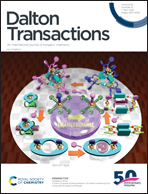Four new Cu6S6 cluster-based coordination compounds: synthesis, crystal structures and fluorescence properties†
Abstract
A hexagonal prismatic Cu6S6 cluster exhibits excellent near-infrared fluorescence properties due to its short Cu–Cu bonds, however, the construction of Cu6S6 cluster-based compounds with extended structures is still a challenge. Here, four new Cu6S6 cluster-based coordination compounds, formulated as Cu3(pymt)3 (1), {(CuCN)2[Cu3(mpymt)3]}n (2), {(CuSCN)[Cu3(mpymt)3]}n (3) and {(CuCN)2[Cu3(dmpymt)3]·CH3CN}n (4) (Hpymt = pyrimidine-2-thiolate, Hmpymt = 4-methyl-pyrimidine-2-thione and Hdmpymt = 4,6-dimethylpyrimidine-2-thione), have been synthesized through the reactions of mercaptopyrimidine derivatives and CuCN or CuSCN under solvo-thermal conditions and characterized by single-crystal X-ray diffraction, powder X-ray diffraction, IR spectroscopy, elemental analysis, and thermal gravimetric analysis. Single-crystal X-ray diffraction analysis reveals that compound 1 is a zero-dimensional Cu6(pymt)6 molecule containing a distorted pseudo-hexagonal prismatic Cu6S6 core. Compounds 2 and 4 with isomorphic frameworks but different organic linkers show a rare three-dimensional framework with nor topology constructed from Cu6(mpymt)6 units and one-dimensional chiral [Cu(CN)]n chains; compared with compound 2, a more hydrophobic one-dimensional channel in compound 4 is observed due to the increase of the methyl groups on the pyrimidine ligand, in which acetonitrile molecules are filled in the channels of compound 4. Compound 3 shows a rare two-dimensional layer constructed from Cu6(mpymt)6 units and one-dimensional puckered (CuSCN)n chains. For the first time, Cu6S6 clusters are connected to one-dimensional inorganic CuCN (or CuSCN) chains through mercaptopyrimidine derivatives to obtain extended arrays in compounds 2–4. The crystals of compounds 1–4 in the solid state all show apparent red light emission. Compound 4 shows sensitive luminescence quenching response to nitrobenzene (NB), and the corresponding quenching constant (Ksv) and detection limit are 2.06 × 103 M−1 and 9.27 ppm, respectively. This study provides a new strategy to construct Cu6S6 cluster-based coordination polymers that have great potential in various applications such as luminescence sensing.



 Please wait while we load your content...
Please wait while we load your content...